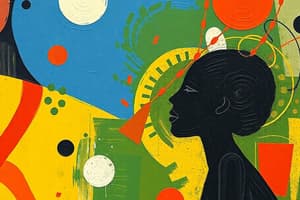Podcast
Questions and Answers
What is added to gelatin to prevent mold growth during the embedding process?
What is added to gelatin to prevent mold growth during the embedding process?
- 1% formaldehyde
- 1% glycerin
- 1% phenol (correct)
- 1% alcohol
Which characteristic of cyclohexene dioxide makes it distinct compared to other epoxy plastics?
Which characteristic of cyclohexene dioxide makes it distinct compared to other epoxy plastics?
- It has a higher viscosity
- It is impure with high viscosity
- It is pure with very low viscosity (correct)
- It infiltrates at the slowest rate
For what primary application is gelatin rarely used?
For what primary application is gelatin rarely used?
- Microscopic imaging (correct)
- Avoiding dehydration
- Embedding delicate specimens
- Histochemical studies
What is the maximum tissue thickness requirement for using gelatin?
What is the maximum tissue thickness requirement for using gelatin?
Why are polyester plastics now seldom used in comparison to their initial introduction?
Why are polyester plastics now seldom used in comparison to their initial introduction?
What is the primary purpose of using 10% formalin in routine fixation?
What is the primary purpose of using 10% formalin in routine fixation?
How long should routine fixation typically last?
How long should routine fixation typically last?
What effect does a pH greater than 4.6 have on the fixation process?
What effect does a pH greater than 4.6 have on the fixation process?
What is the rate of penetration for routine fixation?
What is the rate of penetration for routine fixation?
What is a major factor that improves the fixation process?
What is a major factor that improves the fixation process?
What is the consequence of using glacial acetic acid in fixation?
What is the consequence of using glacial acetic acid in fixation?
Which type of fixative acts on nuclear structures according to action?
Which type of fixative acts on nuclear structures according to action?
Which of the following is true regarding larger tissues in fixation?
Which of the following is true regarding larger tissues in fixation?
What is the primary purpose of the impregnation/infiltration process in tissue processing?
What is the primary purpose of the impregnation/infiltration process in tissue processing?
Which embedding medium is noted as the simplest and most common?
Which embedding medium is noted as the simplest and most common?
At what temperature is the routine melting point of paraffin wax?
At what temperature is the routine melting point of paraffin wax?
What ratio should be maintained between the impregnation agent and tissue during infiltration?
What ratio should be maintained between the impregnation agent and tissue during infiltration?
What are Negri bodies primarily associated with?
What are Negri bodies primarily associated with?
Which factor is crucial for optimal infiltration temperature when using paraffin wax?
Which factor is crucial for optimal infiltration temperature when using paraffin wax?
What is a purity requirement for paraffin wax used in tissue processing?
What is a purity requirement for paraffin wax used in tissue processing?
Which fixation method is preferred for preserving antigenicity in smears of brain tissue?
Which fixation method is preferred for preserving antigenicity in smears of brain tissue?
What is the main purpose of using Carnoy's solution in histological studies?
What is the main purpose of using Carnoy's solution in histological studies?
Which step directly follows the impregnation of tissue during the processing procedure?
Which step directly follows the impregnation of tissue during the processing procedure?
What type of structures does Flemming's fixative primarily prepare for examination?
What type of structures does Flemming's fixative primarily prepare for examination?
For laboratory temperatures of 20-24°C, which melting point wax should be used?
For laboratory temperatures of 20-24°C, which melting point wax should be used?
Which fixative is known for its lipid staining properties?
Which fixative is known for its lipid staining properties?
Which fixing agent acts faster compared to alcoholic formalin?
Which fixing agent acts faster compared to alcoholic formalin?
What is the main component of Flemming's fixative when glacial acetic acid is excluded?
What is the main component of Flemming's fixative when glacial acetic acid is excluded?
What is the ideal temperature range for effective decalcification?
What is the ideal temperature range for effective decalcification?
Which solution is a mixture of ethanol, chloroform, and glacial acetic acid?
Which solution is a mixture of ethanol, chloroform, and glacial acetic acid?
Which decalcification method is known for being the fastest?
Which decalcification method is known for being the fastest?
What can be used to inhibit nuclear staining when using strong acids for decalcification?
What can be used to inhibit nuclear staining when using strong acids for decalcification?
What is the primary mechanism of ion exchange resins in decalcification?
What is the primary mechanism of ion exchange resins in decalcification?
What is the typical decalcification time required for small specimens?
What is the typical decalcification time required for small specimens?
What effect does a temperature of 37°C have during the decalcification process?
What effect does a temperature of 37°C have during the decalcification process?
What is the volume ratio of decalcifying solution to tissue that is generally recommended?
What is the volume ratio of decalcifying solution to tissue that is generally recommended?
For which type of samples is electrolytic decalcification especially effective?
For which type of samples is electrolytic decalcification especially effective?
Flashcards are hidden until you start studying
Study Notes
Fixation
- Purpose of Fixation: To preserve the specific elements of the cell, chemical constituents of cells and tissues, and prevent autolysis of cells
- Fixation Process: Involves replacing the water content of the tissue with fixative agents, which form cross-links and solidify the tissue
- Types of Fixation: Nuclear, Cytological (both preserve cell elements), Histochemical (preserve chemical constituents of cells and tissues)
- Routine Fixation Duration: 2-6 hours
- Electron Microscopy Fixation Duration: 3 hours
- Factors Affecting Fixation:
- **Size & Thickness of tissue:**Larger tissues require more time
- Agitation: Improves the speed of fixation
- Moderate Temperature: Ideal temperature is 18-20°C
- pH: Ideal pH for most fixatives is ≤ 4.6
- Important Note: Glacial acetic acid is used in some nuclear fixatives, but it destroys mitochondria and Golgi bodies, so it is not used in cytoplasmic fixatives
Fixative Types
- Aldehydes: Commonly used fixatives like formaldehyde
- Metallic Fixatives (Mercuric, Chromate): Also used for fixation
- Picric Acid: Another type of fixative
- Glacial Acetic Acid: Used in fixatives for preservation of nuclear structures
- Formalin-Acetic Alcohol: Faster acting than alcoholic formalin, used for diagnostic cryostat sections
- Osmic Acid Fixatives: Strong oxidizing solution used in Electron Microscopy, excellent lipid stain
- Flemming's Solution: Chromic-Osmium Acetic Acid fixative, recommended for nuclear preparation
- Flemmings Without Glacial Acetic Acid: Recommended for preserving cytoplasmic structures, particularly mitochondria
- Trichloroacetic Acid: Another type of fixative, most common decalcifying agent
Decalcification
- Purpose: To remove calcium salts from bone tissue for sectioning and staining
- Common Methods: Chemical (using acids) and Electrolytic
- Decalcification Rate: Can vary, small specimens may take 1-3 weeks, dense cortical bone may take 6-8 weeks or longer
- Microwaves: Can be used to accelerate decalcification, a newer technique
Tissue Processing
- Steps Involved: Fixation, Decalcification, Dehydration, Clearing, Impregnation, Embedding, Trimming, Sectioning, Staining, Mounting, Ringing, Labeling
- Impregnation: Replacing clearing agents with a medium to fill tissue cavities, ensuring proper support for cutting and staining
- Embedding: Incorporating tissue into a medium for sectioning, typically paraffin wax
Embedding Mediums
- Paraffin Wax: Most common embedding medium, suitable for routine histological studies
- Celluloidin: Another type of embedding medium, particularly for preserving large tissues
- Gelatin: Used for delicate specimens and frozen sections, avoids dehydration
- Plastic: Epoxy resin, used for electron microscopy and special staining techniques
Paraffin Wax
- Ideal Infiltration Temperature: 2-5°C above melting point
- Routine Melting Point: 66°C
- Viscosity: Lower than other embedding mediums
- Purity Requirements: Free from dust, water, and foreign matter
Other Embedding Mediums
- Cyclohexene Dioxide: Known as SPURR, very low viscosity, rapid infiltration
- Polyester Plastics: Originally for electron microscopy, now used less frequently
Studying That Suits You
Use AI to generate personalized quizzes and flashcards to suit your learning preferences.




